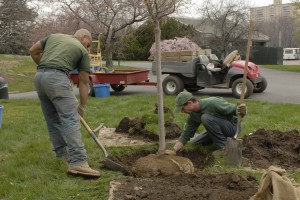Tip of the Week: A Million Trees? Try This New Planting Method
Posted in Gardening Tips on February 1 2010, by Sonia Uyterhoeven
 |
Sonia Uyterhoeven is Gardener for Public Education. |
 One of the highest arts or noblest feats in life is to put new and ambitious ideas into practice. New Yorkers were promised “a million trees” to green the city, combat greenhouse gases, and improve the quality of life. Can it be done? Thanks to some phenomenal research by the Urban Horticulture Institute at Cornell University that makes planting street trees easier, the answer from the horticultural side of the equation is “yes.”
One of the highest arts or noblest feats in life is to put new and ambitious ideas into practice. New Yorkers were promised “a million trees” to green the city, combat greenhouse gases, and improve the quality of life. Can it be done? Thanks to some phenomenal research by the Urban Horticulture Institute at Cornell University that makes planting street trees easier, the answer from the horticultural side of the equation is “yes.”
Trees are sold three ways—balled and burlapped (B&B, see photo), container grown, or bare root. They all have their advantages and disadvantages when it comes time to plant.
B&B used to be the traditional way to plant street trees. The root ball is surrounded by a protective layer of soil that prevents the roots from desiccating. There are several drawbacks to this method. First, root balls are very heavy; it takes an enormous amount of manpower and often machinery to plant B&B trees. They also can be pricey. In addition, as much as 90 percent of the roots can be lost during harvesting, so you would be placing a severely compromised tree into an already inhospitable urban environment. And because the root flare of the tree is often hidden in a B&B, the tree gets planted too deep. This results in the surface roots not getting enough oxygen and the tree ultimately dying.
Container-grown trees are expensive, and they are often susceptible to circling roots, which compromises the vigor of the tree. An innovation I saw at several botanical gardens in Great Britain but have yet to see on the consumer market are “air pots.” Holes or slits in the containers let in light, so that the roots are encourage to branch, instead of growing outward and circling around the pot. You end up with a dense root system that is confined to the size of the container.
Bare root trees are generally half the price of B&B or container trees, lightweight, easy to plant, and possess a healthy root system. In the past, the problem with these has been desiccation—once harvested, how can the roots be kept hydrated until the tree is ready to be planted?
The folks at Cornell have come up with an answer: They dip the root system in a slurry or mix of hydrogel and compost. Hydrogels are polymers that absorb and hold water. The bare tree roots are covered with this protective coating, which allows for successful transit from nursery to planting site. The Urban Horticulture Institute provides more information on the particulars of this process as well as a guide to planting bare root trees, with an appendix to many common street trees.
Remember, our aim here is to find a way to plant a million trees in the most expeditious and economical fashion. This new method of bare root planting has been successfully tested in Ithaca and offers a good option for New York City. In next week’s blog, I’ll talk about more advances and advice for urban tree planting—much of which is applicable for those of you planting trees in the suburbs, too.

